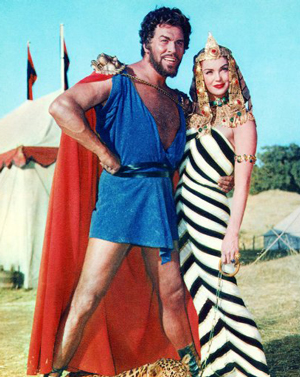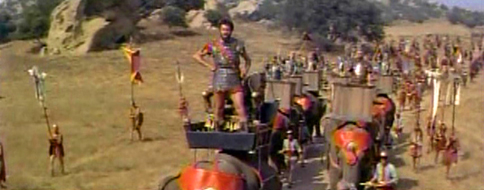Reviewed by Glenn Erickson
It might not seem so until one looks more closely, but in 1955 the mighty MGM Studio was practically folding up. Only a few productions were moving through the enormous movie factory, which must have been a morale disaster for once-bustling departments plagued with layoffs and some services being hired from the outside. Just seven or eight years before Metro had held a gala celebration, one of those things where a couple of hundred major stars -- most of them on the payroll -- posed for legendary photos. In '54 or '55 a similar photo was taken and with maybe fifteen personalities putting on their best faces. Only a few of them were still on contract, and those may have been making their final films for the studio. Off to right is major star and swimsuit icon Esther Williams, wearing a cute Roman outfit with a short pleated skirt -- her famous legs dominate the photo. Esther seems to be in the midst of filming Jupiter's Darling, a pleasant, diverting and often funny comic musical with Howard Keel. It would be her last MGM picture.

In terms of 1955 movie trends, many of those stars and many of the kinds of movies MGM had been famous for were dead in the water. James Dean and teen angst were in, and flashy musicals were on the way out. Having won the executive-office battle with Louis B. Mayer, Dore Schary was not long for Culver City as well; one of his last green-lit pictures was Forbidden Planet, an anomaly in that it was something fresh and new. Perhaps Schary thought that all the construction needed for the space movie would keep more MGM departments open... ?
Jupiter's Darling makes use of MGM's production assets as well, mounting an army of Carthaginians to challenge the power of Rome. Adapting from a play, Dorothy Kingsley's (Seven Brides for Seven Brothers) screenplay emphasizes farce and fun. The show is trivial, but depending on one's tastes, also a treat. A couple of big musical stars would return in the next couple of years to try to re-ignite the MGM musical, but this show sees the end of the mid-range musicals that Leo once turned out five or six times a year.

The calendar reads 216 B.C.. Hannibal's army has crossed the Alps and is closing on Rome, which is woefully unprepared to oppose him. Ruler Fabius Maximus (George Sanders) doesn't know what to do, so his spirited, athletic fianceé Amytis (Esther Williams, singing voice Jo Ann Greer) takes it upon herself to jump in her chariot with her maidservant Meta (Marge Champion) to see what this Hannibal is all about. They're captured, but the lusty Hannibal (Howard Keel) ignores the advice of his aggressive brother Mago (William Demarest) to put them to the sword. Amytis and Hannibal begin a testy courting period, while Meta rejoins Varius (Gower Champion), a Carthaginian front man recently escaped from service as a slave. Events move from silly to ridiculous as Hannibal and Amytis' lovemaking stalls Mago's big plans to storm Rome. Meta and Varius fall in love while tending Hannibal's war pachyderms. Amytis takes Hannibal forward to show him a secret entrance through Rome's walls, but also to persuade him that such a glorious city shouldn't be sacked and burned. Meanwhile, the notion surfaces among the Romans that Amytis is nobly sacrificing herself to the barbarian Hannibal to save her people. Poor duped Fabius Maximus must put up a fight just to save his pride.
Jupiter's Darling is a spoof all the way, although its gentle ribbing of costume pictures conventions never gets as wild as it might. The dialogue plays word games and teases us with Esther Williams' willingness to submit to the handsome Hannibal, if he'll just get his mind on romance instead of war strategies. For the most part George Sidney keeps the CinemaScope camera at arm's length and just lets things happen. A few opportunities are missed. Preston Sturges graduate William Demarest is Hannibal's combat-minded brother, forever hinting that all would be fine if the two Roman women were taken behind a tent and quietly killed. Demarest's gravelly accent is a welcome comic contrast with the stylized 'ancient' talk around him, and he's not used enough.

Also dragging things down are the dull locations in the Southern California scrub. We're glad the film wasn't made on cheap sets, but the impressive elephant army tends to look like Ringling Bros. on a lunch break. Richard Haydn strums his lyre and tries to narrate the show as if it were a serious ode to a momentous historical event. He looks like he's afraid of stepping on an anthill. Elsewhere we see some familiar Roman Steps, a back lot set that seems only minimally patched up to serve on this picture. And a section of a Roman wall for a final battle confrontation looks exactly like what it is, a nondescript remnant of a larger set for some earlier picture.
With those reservations over, it's time to sell the charms of Jupiter's Darling. Esther Williams and Howard Keel make an attractive, funny couple, with just enough glamour between them to pull off the film's argumentative romance. The song Hannibal's Victory March is great, with Howard Keel happily singing about himself as the Conqueror of the World. Other songs aren't quite as memorable, and a couple were cut out to bring the show down to a reasonable length.
Clearly filmed with special effort is a complicated CinemaScope scene in which Amytis swim-dances with a quartet of Roman statues -- all underwater. We eventually stop wondering how everyone's holding their breath -- there must be air hoses behind every pillar. A little underwater cupid even gets into the act, shooting a little animated arrow. It's one of only a couple of swimming scenes for Esther Williams, but she ends her ten-year stint as an MGM water nymph in high style.

A special treat is to see dancing couple Marge and Gower Champion in perhaps their best MGM vehicle. An extended The Life of an Elephant musical number looks extremely difficult in terms of training, animal choreography and timing; I haven't seen anything as complex and ambitious done with elephants. It's just delightful, especially when Marge 'dances' with a baby elephant. The number is nicely composed for the wide screen; the only thing holding it back is the flat exterior high-noon lighting. With a better look this would have been a classic musical number - imagine if Singin' in the Rain's big "Broadway Melody" number had been filmed with the exact same choreography, but on a sunlit parking lot instead of gaudy interior sets.
The Champions are at the top of the great musical and dancing talent MGM gathered just as the genre was fading in popularity -- I always think of likeable people like Bobby Van, who never got the chance to really show what he could do. All of these performers progressed to rewarding careers on TV variety shows, but history shines brighter on folk like Debbie Reynolds, who was immortalized on film just before the door slammed shut.
The conclusion is a bit like The Pirate with Williams' Amytis pretending to sacrifice herself to Hannibal, while fending off Fabius Maximus' desperate negotiations to save her from a fate worse than death. Poor George Sanders has to play the dope, which doesn't seem right. Norma Varden is given a couple of good moments as a patrician lady, while Bruno VeSota and Paul Maxey have bits as overfed Romans.
The Warner Archive Collection DVD-R of Jupiter's Darling is a good enhanced transfer of this late-era MGM musical, that was not even released in Technicolor. The "color by Eastmancolor" has held up well, and we have no complaints with the WAC's remastering job.

The massive credit block on the back of the package indicates that the Studio Days were closing fast -- when glorified bit player Michael Ansara receives full billing, it can only mean that he and many other credited folk had to be hired from outside, a new deal that gave agents more bargaining power. Perhaps the biggest winner in Jupiter's Darling is producer George Wells, a successful writer who stayed on mostly writing MGM product through the 1960s, with an impressive string of popular pictures.
The box says that the disc is in Dolby Stereo. A rather desperate trailer is included. It touts Jupiter's Darling as the entertainment of the year but seems also to say, "tell your mother, maybe she wants to see it." I think we're in a better position to appreciate the film today.
On a scale of Excellent, Good, Fair, and Poor,
Jupiter's Darling rates:
Movie: Good +
Video: Very Good
Sound: Excellent
Supplements: Trailer
Deaf and Hearing Impaired Friendly?
N0; Subtitles: None
Packaging: Keep case
Reviewed: February 25, 2014

Text © Copyright 2014 Glenn Erickson
See more exclusive reviews on the Savant Main Page.
Reviews on the Savant main site have additional credits information and are often updated and annotated with reader input and graphics.
T'was Ever Thus.
Return to Top of Page
|



